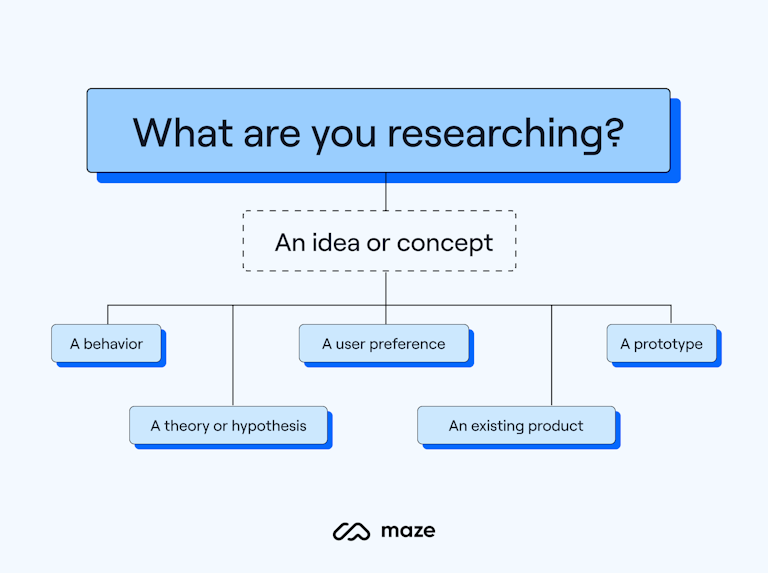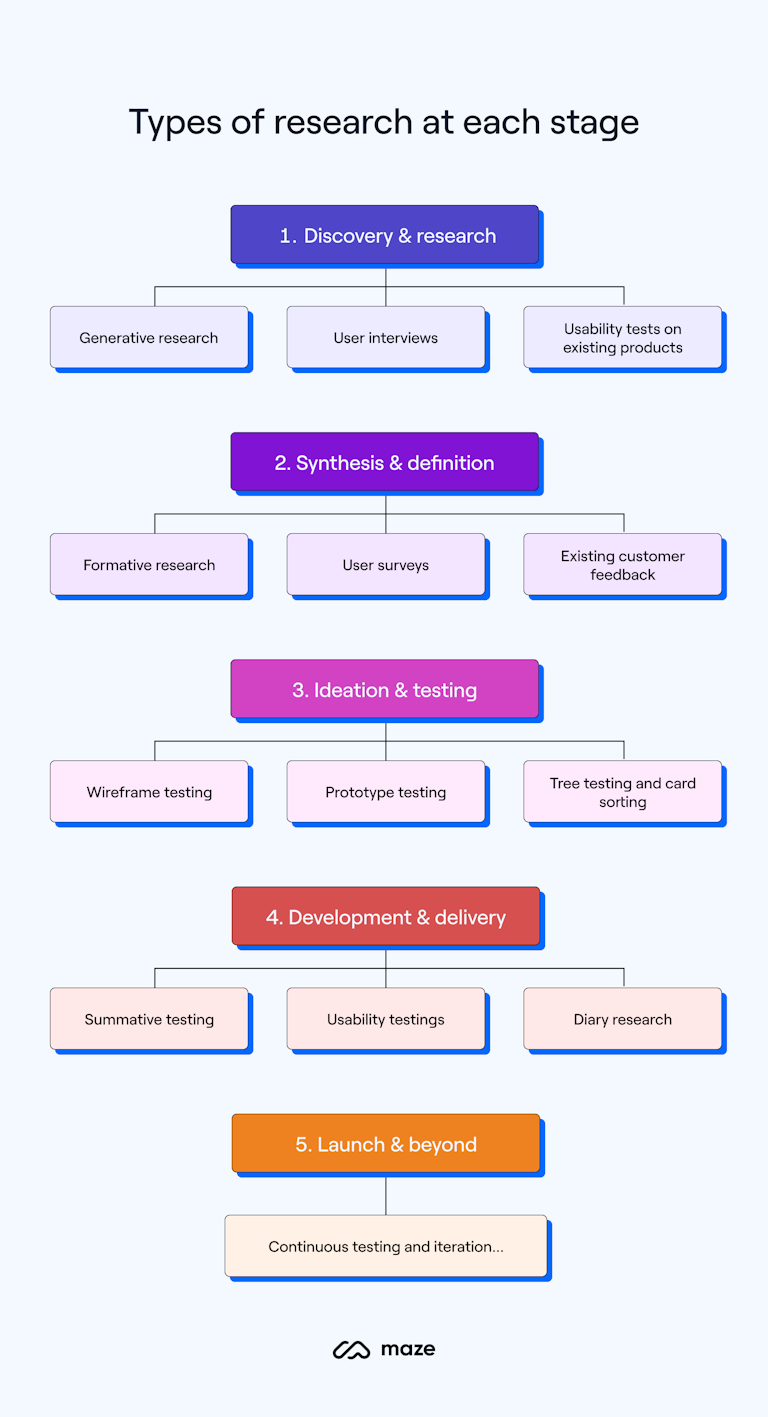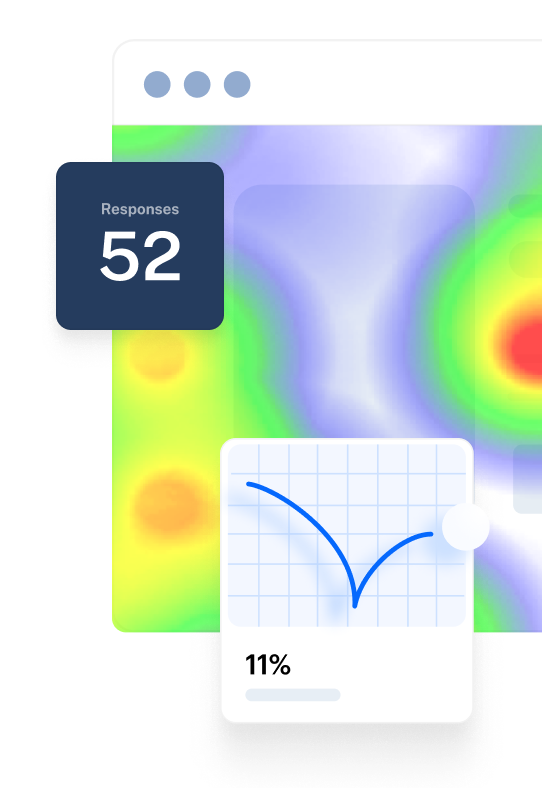Chapter 2
Building a UX research strategy that aligns with business goals
Take a deep dive into UX research strategies: key considerations before getting started, how to assemble your team, and steps to build a strategy informed by business goals.
The old anecdote goes that ‘anything worth doing at all is worth doing well’, and UX research is no different. If you’re investing time and resources into UX research, it deserves to be conducted properly.
When it comes to UX, that means you need a robust UX research strategy.
What is a UX research strategy?
Let’s start with what we mean by UX research strategy.
A UX research strategy is the guiding plan for everything you do related to UX research. This means what research you do, when and how you do it. Your UX research strategy is also a way of democratizing research and cultivating an atmosphere of constant iteration and investigation through timely research.
In its simplest form, a UX research strategy is a plan of action to help you achieve your design research goals. It establishes a shared vision of what you’re aiming to achieve and who to involve along the process.
Eddie Saia
Senior Experience Designer @ ENGINE
Share
Why you need a UX research strategy
Having a solid UX research strategy in place serves several purposes, most namely:
- To emphasize the value of research across your organization and teams; to get stakeholders on board and involved
- To oversee and guide your individual UX research projects and provide a guiding set of principles, checkpoints, best practices, and goals
Think of a UX research strategy as a North Star to guide your research plans and ensure everyone involved is aligned to the same objectives and UX research methods.
UX research strategy is about establishing key research objectives, and identifying the activities required to give you the insights needed to achieve those objectives.
Nazar Ali Khan
Digital UX Strategy Lead @ Economist Impact
Share
Without a thoughtful UX research strategy, you can end up floundering—using up resources on ill-timed or irrelevant research attempts. These may still yield data, but the data will lack purpose and may not answer the questions you’re looking to answer.
UX research strategy vs. UX strategy: What’s the difference?
With so many strategic and UX-related terms thrown about, it can be a little confusing to nail down what strategies or plans you need for what. This chapter should clear up just what UX research strategy is—and what it’s not.
UX research strategy is a defined set of investigative actions that create a path to find the truth to a problem, or the reality of an experience from the user's perspective. Ultimately it is a plan on how we move from uninformed opinions to informed ones.
Joe Smith
Co-founder, UX & Service Design Director @ Sunny Lemons
Share
While your UX research strategy will fit within your wider UX strategy, they’re not the same thing.
A UX research strategy is a focused strategy concerned with how you collect data about user needs and behavior, and the ethos behind that research. It outlines the methods and techniques used to gather user insights to inform the product design and development process.
On the other hand, a UX strategy is an overarching plan of action that outlines how to develop a product or service's user experience to align with product goals and business objectives. It's a guide to ensure your final product offers a positive user experience.
UX strategy deals with the bigger picture of how to design the user experience, while a UX research strategy zeroes in on the research aspect specifically.
5 Questions to ask before planning your UX research strategy
It’s a lot of responsibility to create a UX research strategy that makes up the overarching set of objectives and attitudes for any UX research you conduct—it’s also a lot of information to include. To make your job easier, we’ve included our tips on what to consider before (and during) your strategizing.
💡 We recommend also featuring these questions in the strategy as starting points for your research team to consider before future individual research projects.
1. Who is your research for?
Before you can begin any research, you need to know who you’re doing the research for. Of course, all UX research is ultimately for the benefit of the user, but consider the immediate purpose and outcome of your research and the long-term research goal—is it to support project proposals going to stakeholders? Or is it more for the product team to review current product iterations?
Nazar Ali Khan, Digital UX Strategy Lead @ Economist Impact, says it's crucial to get buy-in early on:
“It’s important to establish a strategy that ensures the research outputs are relevant and meaningful for interested parties—colleagues may be depending on actionable insights to make business-critical decisions. Stakeholders may be skeptical about the value of research, so you should be able to clearly communicate what you’re doing and why you’re doing it.”
Determining who you’re researching for helps ensure any subsequent decisions (e.g. methods, analysis types) are made with the relevant people, and results, in mind.
2. Why are you researching?
Next, you need to nail down why you’re researching. Your research goals will significantly impact the kind of research you do, the methods you use, and when you run the studies—so the importance of knowing why you’re researching can’t be overstated.
Generally, your reason for researching may be to:
- Validate an idea, hypothesis, or prototype (aka evaluative research)
- Generate ideas or gather data (aka generative research)
3. What are you researching?
Related to the why is the what; what are you researching? The possibilities are endless and will vary between individual projects, so it’s crucial to narrow down what your overall UX research focus is. Once you’ve nailed down the specifics of what you’re studying, you can ensure any participants are appropriate and pick the ideal research method.

4. When will you conduct your research?
Deciding when to press ‘go’ on your research is tricky. It often comes down to ‘when the prototype is ready’, but for some research the when is more important. For example, if you’re researching the use of a de-icer car spray, researching in the height of summer won’t be much good.
Remember to think about both the calendar timing and the timing of what product design stage you’re in. The best research is done early and often; we suggest conducting some sort of research at each stage of the product development process, along with any time you’re making decisions that will impact end-users.
Here are the different types of research that can line up with specific stages of a product development lifecycle, from discovery to post-launch.

Discovery & research
This initial stage is all about exploring the problem space and gathering insights to inform the product direction.
- Generative research: Open-ended exploration to uncover user needs, motivations, and pain points. For example, observing how people currently solve a problem that your product aims to address.
- User interviews: In-depth, one-on-one conversations to gather qualitative insights. Ask open-ended questions to understand user behaviors, preferences, and frustrations.
- Usability tests: Evaluate current solutions in the market to identify opportunities for improvement. This can involve testing competitor products or your own existing offering if you're working on an iteration.
Synthesis & definition
In this stage, the team combines findings from discovery research to define the product requirements and strategy. Additional targeted research helps validate and refine the product concepts before moving into detailed design.
- Formative research: More targeted research to define product requirements and direction based on learnings from the discovery phase. This often involves exploring and testing initial concepts.
- User surveys: Quantitative questionnaires sent to a larger sample of your target audience to validate findings and measure attitudes, preferences, or satisfaction at scale.
- Existing customer feedback: Feedback analysis from current customers via support channels, product reviews, social media, etc. Look for recurring themes or issues to address.
Ideation & testing
Research shifts to gathering feedback on prototypes to assess usability, desirability, and feasibility. The insights help shape the product as it's progressively refined.
- Wireframe testing: Quick feedback on low-fidelity sketches or basic prototypes to iterate on the core product concept, information architecture, and layout. This helps test multiple directions before investing in higher-fidelity designs.
- Prototype testing: Evaluating interactive prototypes with target users to validate the design direction, flow, and key interactions. Identify any usability issues or points of confusion early while there's still time to course correct.
- Tree testing and card sorting: Tree tests assess whether the proposed structure enables users to easily find what they need. Card sorting exercises help to generate or validate the categories and labels.
Development & delivery
As the product moves into development, research focuses on validating the design and ironing out any issues before launch.
- Summative testing: Evaluation of the complete product to ensure it meets requirements and performance benchmarks before rollout. The focus is on validating the finished design rather than generating new insights.
- Usability testing: Research sessions where target users complete specific tasks within the product while sharing their thoughts. Identifies any remaining friction points or bugs to be ironed out pre-launch.
- Diary research: Participants record their experiences using a product over time in their own environment. This provides longitudinal data into how the product fits into their lives.
Launch & beyond
Research doesn't stop once a product is launched. Continuous testing and learning are key to optimizing the user experience and informing future iterations based on real-world usage data and changing needs over time.
- Continuous testing and iteration: Regularly gathering user feedback and conducting research to inform future optimizations or new feature development. For example, A/B testing different variations, analyzing user behavior data, or running satisfaction surveys. The goal is to always be learning and improving the product based on real-world usage patterns and evolving customer needs.
There may never be the ‘perfect’ time for your research, but—depending on your focus and design stage—there could be a wrong time, so it’s worth flagging this in your UX research strategy. We cover more on choosing the right methodologies in the UX research strategy stages later in this chapter.
5. How will your research support business goals?
Like any element of an organization, UX research needs to offer value and serve a business purpose in a demonstrable way, so it’s worth mapping this out in your UX research strategy by including documentation evidencing the value of UX research in a concise, measurable way.
Joe Smith, Co-founder, UX & Service Design Director @ Sunny Lemons, emphasizes the importance of aligning business and research:
“Your research strategy will work best when it’s aligned with your business strategy. Before starting you should have clearly defined business goals. These are not the goals of the research itself but the flag in the ground for the business. The research is likely informing a decision on activities that are pushing towards a specific goal.”
You can consider conducting stakeholder or executive interviews to understand current opinions and attitudes to research. It’s also worth offering clear guidance for individual research projects on feeding back specific metrics and showcasing results, so internal stakeholders can see ongoing work and its input.
As Joe says, your research should ultimately tie back to business goals. Good research is done to impact or guide decision-making—whether this is about what product to to build, what solution to prioritize, or something else—these decisions tie back into organizational objectives. In the end, if your research isn’t for decision-making, and impacting decision-making, then it’s likely not that effective.
There’s always more to think about when it comes to research—like what UX research method to use, or what research tool to opt for—but this will be decided on a case-by-case research project basis. Start with the questions above, and you’ll have a foundation to guide your work moving forward.
Building your UX research team
Part of creating a successful UX research strategy is having the right people around to help. Whether your research team is already formed, growing rapidly, or you’re just getting started, building the dream team is crucial.
The research strategy aligns the whole team on how—and most importantly, why—we are conducting the research, preventing a false consensus.
Joe Smith
Co-founder, UX & Service Design Director @ Sunny Lemons
Share
To help, we spoke to several senior UX researchers to discuss the roles you should look to fill in your team.
Research lead
Your UX research lead is the captain of your research team. They’ll work closely with the team lead to strategize on both a UX-specific and business-wide level. While strategy and people management is a large portion of this role, you want to look for someone with plenty of experience who’s not afraid to get their hands dirty helping out with day-to-day research tasks, too.
Adaptability is a key skill to look for, notes Nazar Ali Khan, Digital UX Strategy Lead at Economist Impact:
“You need team members who are comfortable with the organizational and administrative aspects of the work, but can equally be agile and prepared to improvise when the situation calls for it. There’s also a need to be genuinely interested in people and their stories, and enjoyment to be gained from putting your case together.”
UX researcher
Likely making up the bulk of your UX research team, UX researchers will spend each day conducting and analyzing UX research. With a detailed understanding of UX—perhaps a background in other kinds of research or UX design—these team members should have an in-depth knowledge of multiple UX research methods and types of analysis, making them the go-to person for any and all-things UX research.
Joe Smith, Co-founder, UX & Service Design Director at Sunny Lemons, notes that a two-team research team is ideal for starting out.
“Finding one qualitative researcher who can conduct interviews and empathetic research, and another with statistical skills who can analyze data on large scales is ideal. This tandem often helps find patterns effectively and communicate those findings correctly.”
Data analyst
If you have room in your budget, it’s well worth investing in space for a focused data analyst. Your UX researchers may fit the bill well, but provision of a specific role for analysis will free up significant time for UX researchers to focus on planning and conducting the research.
Eddie Saia, Senior Experience Designer at ENGINE, suggests looking for organized, data-focused candidates:
“Individuals with an eye for trends and structure are invaluable throughout the research process. The same goes for individuals who can help to organize and shape the structure of your investigation—making sure it stays in line with the overall strategy and delivered in a way that is both relatable and meaningful.”
Program manager
The final (optional, but invaluable) member of your team is a program manager. Known as UX Research Operations Coordinators in the Gitlab UX research team, this person is your organization hero; they’ll own the participant recruitment process and management, plus anything else related to the logistics of UX research—from location and equipment sourcing, to ensuring participants have everything they need before and after research.
Eddie emphasizes the importance of organization: “If you’re fortunate enough to have access to a wider team then make sure there are enough players to run through the nitty-gritty of research. Capturing and organizing data takes time, so establishing who does what (and when) is key to streamlining the process.”
The 6 stages of your UX research strategy
Now you know how to build the ultimate UX research team, let’s get into the strategy—here’s our five steps to a successful UX research strategy.
Psst: If you’re looking for how to establish a research process, click the link 📎
1: Build research into your organization’s decision-making
The best UX research strategy is built in collaboration with business strategy. Today, while many company leaders see the value of UX research, this isn’t enough—to truly excel, we need to democratize research and use it to inform everything we do.
Like all elements of the design process, research is a team game - your stakeholders are essential members. And whilst they may not always participate in research, they should be taken along the journey… Share research in a way that makes your data relatable—you’re aiming for everyone around the table to share the ‘aha!’ moment, not just fellow researchers or designers.
Eddie Saia
Senior Experience Designer @ ENGINE
Share
This means you need to involve internal stakeholders and business leaders in the conversation, and work together to align strategies and ensure research will support the business objectives and product roadmap.
In short, we must build research into not just the foundation of an organization, but the blueprint, the building materials, and the decor.
2: Gather your team
Next up is building your UX research team—you may already have in-house researchers as part of your UX team. If you’re looking to set up a new team, either work with an external agency or follow our steps above.
Your UX research strategy should align all team members, creating a culture of constant learning. The strategy focuses the team on the right priorities, driving efficiency, and creating meaning to why team members are asked to take certain actions. Everyone in an organization has an impact on the user experience, whether direct or indirect, and will benefit from a UX research strategy.
Joe Smith
Co-founder, UX & Service Design Director @ Sunny Lemons
Share
Ensure everyone’s on the same page about overarching research strategy; everything from communication guidelines to participant recruitment practices and post-study reporting.
3: Consider UX research methods and participant recruitment options
When creating your research strategy, you need to consider the resources you have available to you—and how that impacts your research options. Some research methods are more accessible, whereas others require greater resources, skills, and budget. Including which research methods are viable and realistic for your organization is key for defining your research strategy.
UX research methods can be broadly categorized into two types:
Qualitative methods: These methods provide rich, in-depth insights into user behaviors, motivations, pain points, and experiences. They help you understand the "why" behind user actions and decisions.
- User interviews
- Focus groups
- Ethnographic studies
- Usability testing
- Diary studies
Quantitative methods: These methods provide numerical data and statistical patterns that can help you identify trends, measure user satisfaction, and make data-driven decisions. They are useful for validating hypotheses and understanding the "what" and "how many" aspects of user behavior.
- Surveys
- A/B testing
- Card sorting
- Tree testing
When selecting UX research tools and methods for your UX project, consider the following factors:
- Research goals and questions
- Available resources (time, budget, and personnel)
- Target audience and their accessibility
- Product development stage
In the early stages of discovery and ideation, qualitative methods are often more valuable as they help you explore user needs, motivations, and contexts. As you move into the design and development stages, quantitative methods become more relevant for validating concepts, prioritizing features, and measuring usability.
However, a well-rounded UX research strategy often includes a mix of both qualitative and quantitative methods to gain a comprehensive understanding of the user experience.
Recruiting the right participants for your UX research is important, as the insights drawn from your research efforts largely depend on whether your participants accurately represent your user base.
Start by defining your user persona based on your target audience, including demographics, behaviors, attitudes, needs, and goals. Establish clear criteria for participant selection, considering technical proficiency and domain knowledge.
Screen potential participants using a survey that asks about their background, behavior, and preferences to ensure they fit your user persona.
You can also recruit participants with research tools. For example:
- Source participants quickly with Maze Panel, filtering based on target demographics and screening questions
- Create a dynamic database of testers with Maze Reach, grouping participants based on traits and metrics, with built-in campaigns for future research

4: Catalog best practices
An underrated element of any UX research strategy is best practices. As with any research, consistency is key, so cataloging UX research best practices and any research standards at an organizational level is an important step in your documentation.
Become familiar with tried and trusted techniques and technologies, but be curious and be open to new ones. Plan ahead and establish a clear structure for reporting. Keep building on what you’ve done before. Fuel your enthusiasm for people and solving the right problems for them.
Nazar Ali Khan
Digital UX Strategy Lead @ Economist Impact
Share
Laying out these principles early on will mean any new team members, external agencies, and stakeholders remain aligned. What’s more, it ensures all your research will follow a set standard of ethical and methodological practices, resulting in consistent, high-quality research across the board.
5: Put your plan on paper
This step is all about documentation. Now’s the time to confirm your strategy and record everything—whether you have a single place of truth on an intranet or Notion, catalog your strategy and send it around to stakeholders. It’s also a good idea to include your research strategy in your research repository, even if this is only a link to where you permanently host your strategy documentation.
It’s imperative to communicate this to ensure everyone’s on the same page. That means recording it all: UX team structure, research goals, tool preferences, how your strategy aligns to business objectives, etc. It’s a crucial factor in the success of your research operations.
Communication is king. If your team understands how to conduct your research and remembers to use the insights throughout the project, then the research was successful.
Joe Smith
Co-founder, UX & Service Design Director @ Sunny Lemons
Share
6: Always bring it back to the strategy
Finally, remember to always return to your strategy. When you complete a research project, however big or small, check in with your UX research strategy—did you find the documentation clear? Were you able to tie research back into business objectives and communicate with stakeholders? Did you deviate from anything in the strategy, does this suggest any needed changes? By revisiting your strategy after research—as well as before embarking on a project—you’re able to keep momentum and move forward with an effective strategy.
Risks of having no UX research strategy
Investing in a UX research strategy is important for creating successful, user-centric products. Without a clear plan for understanding and addressing user needs, your UXR teams risk facing challenges at every stage of the product development lifecycle. These issues can range from misaligned priorities and wasted resources to compliance risks and damaged user trust.
Here are some risks of having a weak, or nonexistent, UX research strategy:
- Misaligned product development: Without a strong UX research strategy, development efforts may not align with actual user needs, leading to products that fail to solve relevant problems or attract the target market
- Ineffective resource allocation: A lack of a well-defined UXR strategy can result in wasted time and resources on low-impact research findings, making it difficult to justify investments and secure stakeholder buy-in
- Inconsistent research efforts: Weak UX research strategies lead to siloed, duplicated, and conflicting research initiatives
- Compliance risks: Overlooking UXR strategy can result in products that fail to meet legal standards for accessibility and usability, exposing the company to potential legal challenges
- Limited organizational influence: When UXR teams can't demonstrate the value of their work, they face resistance from other departments, making it challenging to advocate for UX priorities and evangelize research
- Reactive problem-solving: Inadequate UXR strategies result in usability issues post-launch, leading to costly redesigns, prolonged development cycles, and increased risk of user dissatisfaction and churn
Thinking in the long-term
Yes, UX research is a complicated undertaking, but it’s one well worth investing time in—and building a solid UX research strategy is the first step to mapping your UX research journey.
Conducting research without a plan is the quick path to failure. A strategy is the enabler to conduct the right research, at the right time, for the right purpose.
Joe Smith
Co-founder, UX & Service Design Director @ Sunny Lemons
Share
Consider using UX research tools to help streamline your practices, but it ultimately comes down to your core research principles and building curiosity into your business at a ground-level.
To sustain quality research, you need a quality strategy—one your business, and research team, can grow with. Your UX research strategy should be a living document; iterate at every opportunity, and use it to keep your research fresh and effective, serving current and future UX research needs.
Frequently asked questions about UX research strategy
What is UX research strategy?
What is UX research strategy?
A UX research strategy is the overarching plan for everything your business does related to UX research, including what research you do, how you approach research, and any research principles.
Is UX research different from UX design?
Is UX research different from UX design?
UX research is different from UX design: Where UX design is about designing the user experience, UX research is about understanding what the ideal user experience is, and gathering information about your user’s experience.
What should a UX research strategy include?
What should a UX research strategy include?
A UX research strategy should include information on your research principles, research best practices, your team make-up, and considerations for researchers to take before embarking on a project.
What’s the difference between UX research strategy and strategic research?
What’s the difference between UX research strategy and strategic research?
The difference is that UX research strategy is focused on the operational aspects of conducting user research for a specific product or service, while strategic research takes a broader, long-term view to inform high-level decision-making and future planning.
It is essential for UX professionals to understand both concepts, as they work together to create an effective UX research practice—UX research strategy ensures that the right research is conducted efficiently to inform design decisions, while strategic research helps align the UX efforts with the bigger picture and future goals of the organization.



